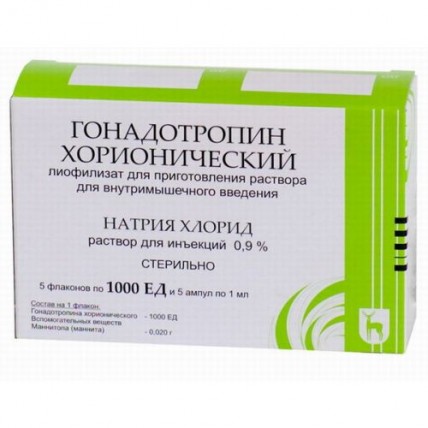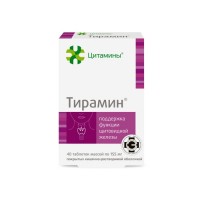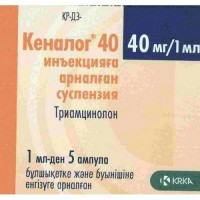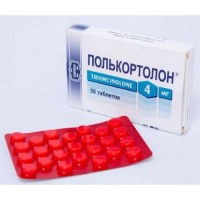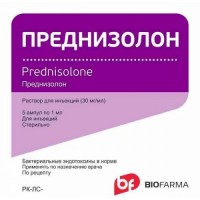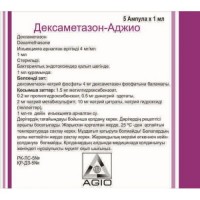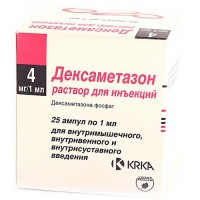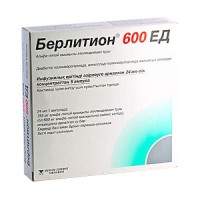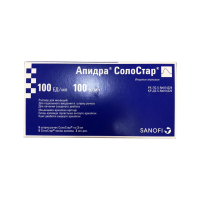Chorionic gonadotropin 1000 U 5's lyophilized powder for injection
- $40.70
Out Of Stock
The instruction for medical use
of medicine
A gonadotrophin chorionic
the Trade name
the Gonadotrophin chorionic
the International unlicensed
name Gonadotrophin chorionic
the Dosage form
Lyophilisate for preparation of solution for intramuscular introduction
Structure
One bottle contains
active agent a gonadotrophin chorionic 500 ME and 1000 ME,
excipient Mannitolum (mannitol).
One ampoule of solvent contains solution of sodium of chloride of 9 mg/ml 1 ml.
The description
the Lyophilized white or almost white powder.
Pharmacotherapeutic group
Sex hormones and modulators of a reproductive system. Gonadotrophins and other stimulators of an ovulation. Gonadotrophins. Chorionic gonadotrophin.
The ATX G03GA01 code
the Pharmacological
Pharmacokinetics Maximum Concentration properties in blood of a gonadotrophin chorionic after
intramuscular introduction is reached in 4-12 hours (depending on
the entered dose).
Elimination half-life makes 8 hours. The most part in the form of fragments - chains, about 10-20% - in not changed look is removed by kidneys.
A pharmacodynamics
the Hormonal drug emitted from urine of pregnant women. Has gonadotropic effect, mainly luteinizing. Stimulates synthesis of sex hormones in ovaries and testicles, an ovulation at women and a spermatogenesis at men. Stimulates development of genitals and secondary sexual characteristics.
Indications
of the Woman:
- dysfunction of ovaries (anovulatory)
- maintenance of a phase of a yellow body
of the Man and boys:
- the hypogonadotropic hypogonadism
- the puberty delay caused by insufficiency of gonadotropic function of a hypophysis
- the cryptorchism which is not caused by anatomic obstruction
- when conducting differential diagnostic test of an anorchism and
cryptorchism at boys
- when carrying out the functional Leydiga test for assessment of function of testicles at a hypogonadotropic hypogonadism before the long-term stimulating treatment
the Route of administration and doses
After addition of solvent to lyophilisate the restored solution of a gonadotrophin chorionic is entered intramusculary, slowly. The prepared solution is not subject to storage as further maintaining sterility of solution is not guaranteed. The specified dosages are approximate, treatment has to be adjusted by the doctor individually depending on necessary reaction to administration of drug.
At women:
- at anovulatory cycles the gonadotrophin chorionic is appointed, since 10-12 in the afternoon a menstrual cycle on 3000 ME 2-3 times with an interval of 2-3 days or on 1500 ME 6-7 times every other day
- for maintenance of a phase of a yellow body from two to three repeated injections of drug in a dose from 1000 ME to 3000 ME everyone within 9 days after an ovulation or transfer of an embryo (for example, for 3, 6 and 9 day after induction of an ovulation)
At men and boys can be made:
- at a hypogonadotropic hypogonadism - 1000-2000 ME of drug 2-3 times a week. In case of infertility, the combination of a gonadotrophin chorionic with the additional drug containing follitropin (follicle-stimulating hormone) 2-3 times a week is possible. The course of treatment has to proceed not less than 3 months when it is possible to expect any improvement of a spermatogenesis. During this treatment it is necessary to suspend replacement therapy by testosterone. When improvement of a spermatogenesis is reached, for its maintenance it is enough, in certain cases, the isolated use of a gonadotrophin chorionic
- at the delay of puberty caused by insufficiency of gonadotropic function of a hypophysis - 1500 ME 2-3 times a week. Course of treatment - not less than 6 months
- at the cryptorchism which is not caused by anatomic obstruction:
aged from 3 up to 6 years - 500-1000 ME twice a week within 6 weeks,
is aged more senior than 6 years-1500 ME twice a week within 6 weeks,
the course of treatment can be in case of need repeated.
- for the purpose of differential diagnostics of a cryptorchism and an anorchism at boys Gonadotropin chorionic is entered intramusculary once in a dosage of 100 ME/kg, concentration of testosterone in blood serum is defined prior to the beginning of the test and by 72-96 h after a drug injection. In case of an anorchism the test will be negative that demonstrates lack of testicular fabric, in case of a cryptorchism even if there is only one small egg, positive (5-10-fold increase in concentration of testosterone). If the test slabopolozhitelny, is necessary search of a gonad (ultrasound examination of an abdominal cavity or laparoscopy) as there is a high risk of a malignancy.
- when carrying out the functional Leydiga test: a gonadotrophin chorionic in a dose 1500 ME enter within 3 days intramusculary, into one and too time, next day after the last injection the blood sampling is carried out and testosterone level is investigated if its increase from reference values for 30-50% or more is observed, then test is estimated as positive, it is preferable to combine this test with carrying out on the same day (the next day after an injection) one more spermogram.
Side effects
of Disturbance from the immune system: in rare instances there can be generalized rash, fever, a Quincke's edema, a small tortoiseshell.
The general disorders and disturbances in the injection site: at use of a gonadotrophin chorionic there can be reactions in the place of an injection, for example, bruise, pain, reddening, a swelling and an itching. It was in certain cases reported about allergic reactions from most of which part was shown in the form of pain and/or rash in the place of an injection, increased fatigue, swell.
Disturbances of mentality: irritability, uneasiness, depression, change of mood.
Disturbances from nervous system: headache, dizziness.
Disturbances from a metabolism and food: increase in weight.
At women:
- disturbances from a reproductive system and mammary glands: moderate and heavy forms of the syndrome of hyper stimulation of ovaries (SHSO).
Moderate degree of SGYa: increase in ovaries of easy and average degree, morbidity in mammary glands, cysts of ovaries, abdominal pain, an abdominal distension, nausea, diarrhea
Heavy degree of SGYa: large cysts of ovaries (inclined to a gap), an acute pain in a stomach, ascites, increase in weight, a hydrothorax, a thrombembolia.
At men and boys:
- disturbances from a metabolism and food: a delay of water and sodium (after reception of big dosages of drug), swell
- disturbances from an endocrine system: premature puberty
- disturbances from skin and hypodermic fabrics: eels
- disturbances from genitals and chest gland: treatment by a gonadotrophin chorionic
the prostate hyperplasia, increase in a penis and erections, hypersensitivity of nipples of chest glands can sporadically cause a gynecomastia in men, increase in testicles in the inguinal channel, at a cryptorchism.
Contraindications
- hypersensitivity to HGCh or to any component of drug
- hormonedependent malignant tumors of genitals and a mammary gland now or suspicion on them (ovary cancer, a breast cancer, uterus cancer at women and a prostate cancer, a carcinoma of chest gland at men)
- organic lesions of the central nervous system (a tumor of a hypophysis, a hypothalamus)
- thrombophlebitis of deep veins
- a hypothyroidism
- adrenal insufficiency
- a giperprolaktinemiya
At boys (in addition):
- premature puberty
At men (in addition):
- the infertility which is not connected with a hypogonadotropic hypogonadism
At women (in addition):
- the malformations of genitals incompatible with pregnancy
- the fibrous tumor of a uterus incompatible with pregnancy
- primary insufficiency of ovaries
- the infertility which is not connected with anovulation (for example, pipe or cervical genesis)
- bleeding or bloody discharges from a vagina of not clear etiology
- pregnancy and the period of breastfeeding
- cysts of ovaries or the increase in ovaries which is not connected with a syndrome of polycystic ovaries (SPKYa).
With care
of the Person, the having risk factors of thrombosis (the personal or family anamnesis, heavy obesity (body mass index & gt, 30 kg/sq.m) or a thrombophilia).
At men and boys with latent or obvious heart failure, a renal failure, arterial hypertension, epilepsy or migraine (or in the presence of these states in the anamnesis), at boys in prepuberty age, at patients with bronchial asthma.
Medicinal interactions
It is necessary to avoid combined use of drug a gonadotrophin chorionic with high doses of glucocorticosteroids.
Other cases of interaction with medicines are noted.
Drug can influence immunological definition of a chorionic gonadotrophin in plasma/urine up to 10 days, the test for pregnancy can be false positive.
Special instructions
the Gonadotrophin chorionic has to be applied only under observation of the specialist doctor.
For women:
Before an initiation of treatment the patient has to undergo gynecologic and endocrinological inspections.
At the pregnancy arising after stimulation of an ovulation gonadotropic drugs there is an increased risk of emergence of polycarpous pregnancy.
At women with disturbance of passability of pipes the risk of developing an extrauterine pregnancy increases. It is important to carry out early ultrasonic diagnosing for definition of an extrauterine pregnancy.
Before treatment it is necessary to exclude uncontrollable gonadal endocrinopathies (for example, disorders of function of thyroid, adrenal or hypophysial glands, diabetes), anatomic anomalies of genitals. Primary insufficiency of ovaries has to be excluded by determination of levels of gonadotrophins.
At the women having risk factors of thrombosis (the personal or family anamnesis, heavy obesity (body mass index & gt, 30 kg/sq.m) or a thrombophilia can be raised risk of a venous or arterial thrombembolia in time or after treatment by gonadotrophins. It should be noted that pregnancy in itself increases risk of developing thromboembolic diseases.
Undesirable hyper stimulation of ovaries can arise at the patients undergoing stimulation of growth of follicles. Undesirable hyper stimulation of ovaries is diagnosed on the basis of ultrasonic inspection. In case of undesirable hyper stimulation of the ovaries administration of drugs containing FSG it has to be immediately stopped. In such cases it is necessary to avoid approach of pregnancy and it is impossible to appoint the Gonadotrophin chorionic as purpose of LG - an active gonadotrophin at this stage can cause, in addition to a multiple ovulation, a syndrome of hyper stimulation of ovaries. These precautionary measures are especially important for patients with a syndrome of polycystic ovaries (SPKYa).
Gastrointestinal disturbances (abdominal pain, nausea, diarrhea), morbidity of mammary glands, increase in ovaries of easy or average degree, cyst of ovaries can be clinical manifestations of SGYa. SGYa of heavy degree which can threaten life was in rare instances noted. These situations are characterized by appearance of large cysts of ovaries (inclined to a gap), ascites, a set of weight, frequent a hydrothorax and sometimes - thromboembolic pneumonia. It was reported about the temporary deviations of results of the tests of function of a liver confirming hepatic dysfunction which can be followed by morphological changes at a liver biopsy connected with the syndrome of hyper stimulation of ovaries (SHSO).
There are messages about developing of a tumor of ovaries and other new growths of a reproductive system as benign and malignant, at women who passed several schemes of treatment of infertility. It is not established whether increases treatment by gonadotrophins risk of developing tumors at women.
Drug a gonadotrophin should not be used for decrease in body weight, the gonadotrophin chorionic does not influence fat metabolism, distribution of fat or to appetite.
For men and boys:
- patients with latent or obvious heart failure, a renal failure, arterial hypertension, epilepsy, bronchial asthma or migraine (or in the presence of these states) have to be in the anamnesis under stringent medical control as exacerbation of a disease or a recurrence can sometimes be result of the raised products of androgens.
- it is necessary to apply with care at boys at prepubertatny age in order to avoid premature closing of epiphyses or premature puberty, it is regularly necessary to control skeletogeny
- drug is inefficient at the high content of follicle-stimulating hormone, unreasonably prolonged use of drug at a cryptorchism, especially, if surgery is shown, can lead to a degeneration of gonads.
Long introduction can lead to antibody formation to drug.
To take to persons with diseases of kidneys with caution.
Use at pregnancy and during breastfeeding
Use during pregnancy and breastfeeding is contraindicated.
The feature of influence of medicine on ability to run the vehicle or other potentially dangerous mechanisms
during treatment needs to abstain from driving of motor transport and occupations potentially dangerous types of activity demanding the increased concentration of attention and speed of psychomotor reactions.
The overdose
Gonadotropin chorionic is characterized extremely by hypotoxicity.
Women against the background of overdose can have a syndrome of hyper stimulation of ovaries (SHSO).
Depending on severity (on the basis of clinical laboratory symptoms), allocate several SGYa types:
Weight
Symptoms
SGYa of easy degree
Abdominal discomfort.
Abdominal pain of insignificant intensity.
Size of ovaries, as a rule, & lt, 8 sm*.
SGYa of average degree
Morbidity of mammary glands. Abdominal pain of average intensity.
Nausea and/or vomiting. Diarrhea. Ultrasonic symptoms of ascites.
Small or average increase in cysts of ovaries.
Size of ovaries, as a rule, 812 sm*.
SGYa of heavy degree
Increase in body weight. In rare instances of a thrombembolia.
Clinical signs of ascites (sometimes hydrothorax).
Oliguria. Haemo concentration, hematocrit & gt, 45%. Hypoproteinemia.
Big cysts of ovaries (inclined to a gap).
Size of ovaries, as a rule, & gt, 12 sm*.
* The size of ovaries can not correlate with severity of SGYa in cycles of the auxiliary reproductive technologies (ART) in connection with carrying out a puncture of follicles.
Treatment at easy degree of SGYa: bed rest, plentiful drink, observation of a condition of the patient.
Treatment of the average and heavy SGYa forms is carried out only in the conditions of a hospital as continuous monitoring of a condition of an organism of the woman and the corresponding treatment is necessary.
At men and boys the development of a gynecomastia is possible, at boys the changes of behavior similar to observed during the first phase of puberty, a degeneration of gonads (are possible at unreasonably prolonged use at a cryptorchism), an atrophy of seed tubules (owing to braking of products of follicle-stimulating hormone (FSG) as a result of stimulation of products of androgens and estrogen), reduction of quantity of spermatozoa in an ejaculate (at abuse of drug at men).
Prolonged use of drug can lead to strengthening of side effects.
The form of release and packing
On 500 and 1000 ME drugs place in glass bottles.
On 1 ml of solvent place in glass ampoules.
On 5 bottles with drug in blister strip packaging complete with 5 ampoules on 1 ml of solvent in blister strip packaging together with the instruction for medical use of drug in the state and Russian languages, the scarificator or a knife ampoule place in a pack from cardboard.
When packing ampoules with notches, rings and points of a break the scarificators or knives ampoule do not invest. Group packing and a transport container according to GOST 17768-90.
To Store storage conditions in the place protected from light, at
a temperature not higher than 20 S. Hranit out of children's reach!
4 years
not to use a period of storage after an expiration date.
Prescription status
According to the prescription
Federal state unitary enterprise Moskovsky Producer the endocrine
plant Russia, Moscow, 109052, Novokhokhlovskaya St., 25
ph./fax (495) 678-00-50, 911-42-10.
The owner of the registration certificate
the Federal state unitary enterprise the Moscow endocrine plant, the Russian Federation
the Address of the organization accepting claims from the consumer on quality of drug in the territory of the Republic of Kazakhstan: SP Nesterenko N.A., Republic of Kazakhstan, 050000, Almaty, Mukanov St., 104,
ph.: +7 7273271602, + 7 7077862629, +7 7058887587, fax +7 2796659,
e-mail: pharm_vigilance@mail.ru., ip_n_nesterenko@list.ru.
To develop
of medicine
A gonadotrophin chorionic
the Trade name
the Gonadotrophin chorionic
the International unlicensed
name Gonadotrophin chorionic
the Dosage form
Lyophilisate for preparation of solution for intramuscular introduction
Structure
One bottle contains
active agent a gonadotrophin chorionic 500 ME and 1000 ME,
excipient Mannitolum (mannitol).
One ampoule of solvent contains solution of sodium of chloride of 9 mg/ml 1 ml.
The description
the Lyophilized white or almost white powder.
Pharmacotherapeutic group
Sex hormones and modulators of a reproductive system. Gonadotrophins and other stimulators of an ovulation. Gonadotrophins. Chorionic gonadotrophin.
The ATX G03GA01 code
the Pharmacological
Pharmacokinetics Maximum Concentration properties in blood of a gonadotrophin chorionic after
intramuscular introduction is reached in 4-12 hours (depending on
the entered dose).
Elimination half-life makes 8 hours. The most part in the form of fragments - chains, about 10-20% - in not changed look is removed by kidneys.
A pharmacodynamics
the Hormonal drug emitted from urine of pregnant women. Has gonadotropic effect, mainly luteinizing. Stimulates synthesis of sex hormones in ovaries and testicles, an ovulation at women and a spermatogenesis at men. Stimulates development of genitals and secondary sexual characteristics.
Indications
of the Woman:
- dysfunction of ovaries (anovulatory)
- maintenance of a phase of a yellow body
of the Man and boys:
- the hypogonadotropic hypogonadism
- the puberty delay caused by insufficiency of gonadotropic function of a hypophysis
- the cryptorchism which is not caused by anatomic obstruction
- when conducting differential diagnostic test of an anorchism and
cryptorchism at boys
- when carrying out the functional Leydiga test for assessment of function of testicles at a hypogonadotropic hypogonadism before the long-term stimulating treatment
the Route of administration and doses
After addition of solvent to lyophilisate the restored solution of a gonadotrophin chorionic is entered intramusculary, slowly. The prepared solution is not subject to storage as further maintaining sterility of solution is not guaranteed. The specified dosages are approximate, treatment has to be adjusted by the doctor individually depending on necessary reaction to administration of drug.
At women:
- at anovulatory cycles the gonadotrophin chorionic is appointed, since 10-12 in the afternoon a menstrual cycle on 3000 ME 2-3 times with an interval of 2-3 days or on 1500 ME 6-7 times every other day
- for maintenance of a phase of a yellow body from two to three repeated injections of drug in a dose from 1000 ME to 3000 ME everyone within 9 days after an ovulation or transfer of an embryo (for example, for 3, 6 and 9 day after induction of an ovulation)
At men and boys can be made:
- at a hypogonadotropic hypogonadism - 1000-2000 ME of drug 2-3 times a week. In case of infertility, the combination of a gonadotrophin chorionic with the additional drug containing follitropin (follicle-stimulating hormone) 2-3 times a week is possible. The course of treatment has to proceed not less than 3 months when it is possible to expect any improvement of a spermatogenesis. During this treatment it is necessary to suspend replacement therapy by testosterone. When improvement of a spermatogenesis is reached, for its maintenance it is enough, in certain cases, the isolated use of a gonadotrophin chorionic
- at the delay of puberty caused by insufficiency of gonadotropic function of a hypophysis - 1500 ME 2-3 times a week. Course of treatment - not less than 6 months
- at the cryptorchism which is not caused by anatomic obstruction:
aged from 3 up to 6 years - 500-1000 ME twice a week within 6 weeks,
is aged more senior than 6 years-1500 ME twice a week within 6 weeks,
the course of treatment can be in case of need repeated.
- for the purpose of differential diagnostics of a cryptorchism and an anorchism at boys Gonadotropin chorionic is entered intramusculary once in a dosage of 100 ME/kg, concentration of testosterone in blood serum is defined prior to the beginning of the test and by 72-96 h after a drug injection. In case of an anorchism the test will be negative that demonstrates lack of testicular fabric, in case of a cryptorchism even if there is only one small egg, positive (5-10-fold increase in concentration of testosterone). If the test slabopolozhitelny, is necessary search of a gonad (ultrasound examination of an abdominal cavity or laparoscopy) as there is a high risk of a malignancy.
- when carrying out the functional Leydiga test: a gonadotrophin chorionic in a dose 1500 ME enter within 3 days intramusculary, into one and too time, next day after the last injection the blood sampling is carried out and testosterone level is investigated if its increase from reference values for 30-50% or more is observed, then test is estimated as positive, it is preferable to combine this test with carrying out on the same day (the next day after an injection) one more spermogram.
Side effects
of Disturbance from the immune system: in rare instances there can be generalized rash, fever, a Quincke's edema, a small tortoiseshell.
The general disorders and disturbances in the injection site: at use of a gonadotrophin chorionic there can be reactions in the place of an injection, for example, bruise, pain, reddening, a swelling and an itching. It was in certain cases reported about allergic reactions from most of which part was shown in the form of pain and/or rash in the place of an injection, increased fatigue, swell.
Disturbances of mentality: irritability, uneasiness, depression, change of mood.
Disturbances from nervous system: headache, dizziness.
Disturbances from a metabolism and food: increase in weight.
At women:
- disturbances from a reproductive system and mammary glands: moderate and heavy forms of the syndrome of hyper stimulation of ovaries (SHSO).
Moderate degree of SGYa: increase in ovaries of easy and average degree, morbidity in mammary glands, cysts of ovaries, abdominal pain, an abdominal distension, nausea, diarrhea
Heavy degree of SGYa: large cysts of ovaries (inclined to a gap), an acute pain in a stomach, ascites, increase in weight, a hydrothorax, a thrombembolia.
At men and boys:
- disturbances from a metabolism and food: a delay of water and sodium (after reception of big dosages of drug), swell
- disturbances from an endocrine system: premature puberty
- disturbances from skin and hypodermic fabrics: eels
- disturbances from genitals and chest gland: treatment by a gonadotrophin chorionic
the prostate hyperplasia, increase in a penis and erections, hypersensitivity of nipples of chest glands can sporadically cause a gynecomastia in men, increase in testicles in the inguinal channel, at a cryptorchism.
Contraindications
- hypersensitivity to HGCh or to any component of drug
- hormonedependent malignant tumors of genitals and a mammary gland now or suspicion on them (ovary cancer, a breast cancer, uterus cancer at women and a prostate cancer, a carcinoma of chest gland at men)
- organic lesions of the central nervous system (a tumor of a hypophysis, a hypothalamus)
- thrombophlebitis of deep veins
- a hypothyroidism
- adrenal insufficiency
- a giperprolaktinemiya
At boys (in addition):
- premature puberty
At men (in addition):
- the infertility which is not connected with a hypogonadotropic hypogonadism
At women (in addition):
- the malformations of genitals incompatible with pregnancy
- the fibrous tumor of a uterus incompatible with pregnancy
- primary insufficiency of ovaries
- the infertility which is not connected with anovulation (for example, pipe or cervical genesis)
- bleeding or bloody discharges from a vagina of not clear etiology
- pregnancy and the period of breastfeeding
- cysts of ovaries or the increase in ovaries which is not connected with a syndrome of polycystic ovaries (SPKYa).
With care
of the Person, the having risk factors of thrombosis (the personal or family anamnesis, heavy obesity (body mass index & gt, 30 kg/sq.m) or a thrombophilia).
At men and boys with latent or obvious heart failure, a renal failure, arterial hypertension, epilepsy or migraine (or in the presence of these states in the anamnesis), at boys in prepuberty age, at patients with bronchial asthma.
Medicinal interactions
It is necessary to avoid combined use of drug a gonadotrophin chorionic with high doses of glucocorticosteroids.
Other cases of interaction with medicines are noted.
Drug can influence immunological definition of a chorionic gonadotrophin in plasma/urine up to 10 days, the test for pregnancy can be false positive.
Special instructions
the Gonadotrophin chorionic has to be applied only under observation of the specialist doctor.
For women:
Before an initiation of treatment the patient has to undergo gynecologic and endocrinological inspections.
At the pregnancy arising after stimulation of an ovulation gonadotropic drugs there is an increased risk of emergence of polycarpous pregnancy.
At women with disturbance of passability of pipes the risk of developing an extrauterine pregnancy increases. It is important to carry out early ultrasonic diagnosing for definition of an extrauterine pregnancy.
Before treatment it is necessary to exclude uncontrollable gonadal endocrinopathies (for example, disorders of function of thyroid, adrenal or hypophysial glands, diabetes), anatomic anomalies of genitals. Primary insufficiency of ovaries has to be excluded by determination of levels of gonadotrophins.
At the women having risk factors of thrombosis (the personal or family anamnesis, heavy obesity (body mass index & gt, 30 kg/sq.m) or a thrombophilia can be raised risk of a venous or arterial thrombembolia in time or after treatment by gonadotrophins. It should be noted that pregnancy in itself increases risk of developing thromboembolic diseases.
Undesirable hyper stimulation of ovaries can arise at the patients undergoing stimulation of growth of follicles. Undesirable hyper stimulation of ovaries is diagnosed on the basis of ultrasonic inspection. In case of undesirable hyper stimulation of the ovaries administration of drugs containing FSG it has to be immediately stopped. In such cases it is necessary to avoid approach of pregnancy and it is impossible to appoint the Gonadotrophin chorionic as purpose of LG - an active gonadotrophin at this stage can cause, in addition to a multiple ovulation, a syndrome of hyper stimulation of ovaries. These precautionary measures are especially important for patients with a syndrome of polycystic ovaries (SPKYa).
Gastrointestinal disturbances (abdominal pain, nausea, diarrhea), morbidity of mammary glands, increase in ovaries of easy or average degree, cyst of ovaries can be clinical manifestations of SGYa. SGYa of heavy degree which can threaten life was in rare instances noted. These situations are characterized by appearance of large cysts of ovaries (inclined to a gap), ascites, a set of weight, frequent a hydrothorax and sometimes - thromboembolic pneumonia. It was reported about the temporary deviations of results of the tests of function of a liver confirming hepatic dysfunction which can be followed by morphological changes at a liver biopsy connected with the syndrome of hyper stimulation of ovaries (SHSO).
There are messages about developing of a tumor of ovaries and other new growths of a reproductive system as benign and malignant, at women who passed several schemes of treatment of infertility. It is not established whether increases treatment by gonadotrophins risk of developing tumors at women.
Drug a gonadotrophin should not be used for decrease in body weight, the gonadotrophin chorionic does not influence fat metabolism, distribution of fat or to appetite.
For men and boys:
- patients with latent or obvious heart failure, a renal failure, arterial hypertension, epilepsy, bronchial asthma or migraine (or in the presence of these states) have to be in the anamnesis under stringent medical control as exacerbation of a disease or a recurrence can sometimes be result of the raised products of androgens.
- it is necessary to apply with care at boys at prepubertatny age in order to avoid premature closing of epiphyses or premature puberty, it is regularly necessary to control skeletogeny
- drug is inefficient at the high content of follicle-stimulating hormone, unreasonably prolonged use of drug at a cryptorchism, especially, if surgery is shown, can lead to a degeneration of gonads.
Long introduction can lead to antibody formation to drug.
To take to persons with diseases of kidneys with caution.
Use at pregnancy and during breastfeeding
Use during pregnancy and breastfeeding is contraindicated.
The feature of influence of medicine on ability to run the vehicle or other potentially dangerous mechanisms
during treatment needs to abstain from driving of motor transport and occupations potentially dangerous types of activity demanding the increased concentration of attention and speed of psychomotor reactions.
The overdose
Gonadotropin chorionic is characterized extremely by hypotoxicity.
Women against the background of overdose can have a syndrome of hyper stimulation of ovaries (SHSO).
Depending on severity (on the basis of clinical laboratory symptoms), allocate several SGYa types:
Weight
Symptoms
SGYa of easy degree
Abdominal discomfort.
Abdominal pain of insignificant intensity.
Size of ovaries, as a rule, & lt, 8 sm*.
SGYa of average degree
Morbidity of mammary glands. Abdominal pain of average intensity.
Nausea and/or vomiting. Diarrhea. Ultrasonic symptoms of ascites.
Small or average increase in cysts of ovaries.
Size of ovaries, as a rule, 812 sm*.
SGYa of heavy degree
Increase in body weight. In rare instances of a thrombembolia.
Clinical signs of ascites (sometimes hydrothorax).
Oliguria. Haemo concentration, hematocrit & gt, 45%. Hypoproteinemia.
Big cysts of ovaries (inclined to a gap).
Size of ovaries, as a rule, & gt, 12 sm*.
* The size of ovaries can not correlate with severity of SGYa in cycles of the auxiliary reproductive technologies (ART) in connection with carrying out a puncture of follicles.
Treatment at easy degree of SGYa: bed rest, plentiful drink, observation of a condition of the patient.
Treatment of the average and heavy SGYa forms is carried out only in the conditions of a hospital as continuous monitoring of a condition of an organism of the woman and the corresponding treatment is necessary.
At men and boys the development of a gynecomastia is possible, at boys the changes of behavior similar to observed during the first phase of puberty, a degeneration of gonads (are possible at unreasonably prolonged use at a cryptorchism), an atrophy of seed tubules (owing to braking of products of follicle-stimulating hormone (FSG) as a result of stimulation of products of androgens and estrogen), reduction of quantity of spermatozoa in an ejaculate (at abuse of drug at men).
Prolonged use of drug can lead to strengthening of side effects.
The form of release and packing
On 500 and 1000 ME drugs place in glass bottles.
On 1 ml of solvent place in glass ampoules.
On 5 bottles with drug in blister strip packaging complete with 5 ampoules on 1 ml of solvent in blister strip packaging together with the instruction for medical use of drug in the state and Russian languages, the scarificator or a knife ampoule place in a pack from cardboard.
When packing ampoules with notches, rings and points of a break the scarificators or knives ampoule do not invest. Group packing and a transport container according to GOST 17768-90.
To Store storage conditions in the place protected from light, at
a temperature not higher than 20 S. Hranit out of children's reach!
4 years
not to use a period of storage after an expiration date.
Prescription status
According to the prescription
Federal state unitary enterprise Moskovsky Producer the endocrine
plant Russia, Moscow, 109052, Novokhokhlovskaya St., 25
ph./fax (495) 678-00-50, 911-42-10.
The owner of the registration certificate
the Federal state unitary enterprise the Moscow endocrine plant, the Russian Federation
the Address of the organization accepting claims from the consumer on quality of drug in the territory of the Republic of Kazakhstan: SP Nesterenko N.A., Republic of Kazakhstan, 050000, Almaty, Mukanov St., 104,
ph.: +7 7273271602, + 7 7077862629, +7 7058887587, fax +7 2796659,
e-mail: pharm_vigilance@mail.ru., ip_n_nesterenko@list.ru.
To develop
